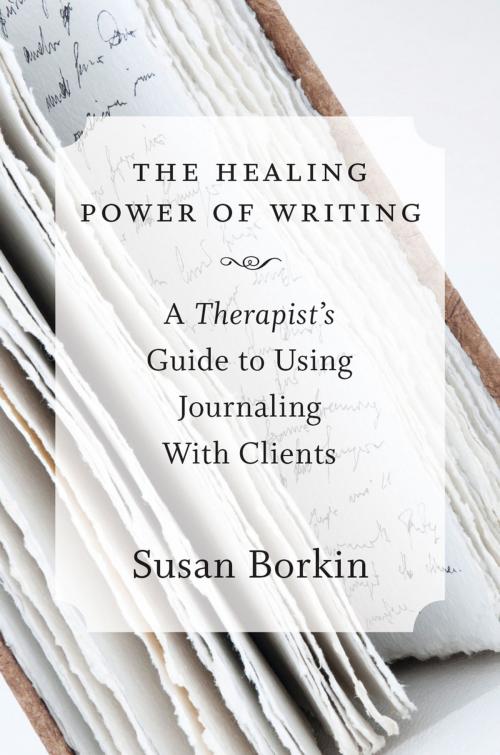The Healing Power of Writing: A Therapist's Guide to Using Journaling With Clients
Nonfiction, Health & Well Being, Psychology, Counselling| Author: | Susan Borkin | ISBN: | 9780393709582 |
| Publisher: | W. W. Norton & Company | Publication: | March 31, 2014 |
| Imprint: | W. W. Norton & Company | Language: | English |
| Author: | Susan Borkin |
| ISBN: | 9780393709582 |
| Publisher: | W. W. Norton & Company |
| Publication: | March 31, 2014 |
| Imprint: | W. W. Norton & Company |
| Language: | English |
The healing benefits of writing can support traditional therapy.
While much has been written about the physical and emotional benefits of writing, little has been written specifically for mental health professionals detailing how to use therapeutic journaling with their clients. Therapeutic journaling—any type of writing or related expressive process used for the purpose of psychological healing or growth—can be an extremely helpful adjunctive therapy. When integrated into an overall treatment plan, regardless of the therapist’s clinical orientation, journaling can become a dynamic tool for personal growth and healing.
The first part of this book, “Journaling and the Clinical Process,” gives an overview of therapeutic journaling and the many potential benefits from its use. It provides concrete and specific steps for introducing journaling to psychotherapy clients and answers questions about structure and logistics. For example, engaging your client in writing a biographical statement will not only help focus the treatment plan but also provide a vast amount of background information. This section also introduces two very beneficial mnemonic devices to help clients focus and organize journaling between sessions.
The next section, “Presenting Problems and Journaling Solutions,” addresses nine different diagnoses and explains specifically how therapeutic journaling can be integrated into the treatment plan of these diagnoses. Key diagnoses are covered: adjustment disorders, anxiety, depression, grief, low self-esteem, couple and relationship issues, addictions, disordered eating, and post-traumatic stress disorder.
The final part of the book, “Journaling Roadblocks and Building Blocks,” addresses potentially difficult, sticky, or challenging situations regarding journaling, such as possible resistance to therapeutic journaling, privacy issues, safe boundaries, and protection of client material. Importantly, it also reviews those circumstances in which it is best not to use therapeutic journaling or when journaling is contraindicated. The author offers a program designed for therapists for creating their own therapeutic journaling practice.
The Healing Power of Writing is filled with case studies, step-by-step exercises, and clear and practical guidelines for mental health professionals who want to incorporate journaling into their clients’ treatment.
The healing benefits of writing can support traditional therapy.
While much has been written about the physical and emotional benefits of writing, little has been written specifically for mental health professionals detailing how to use therapeutic journaling with their clients. Therapeutic journaling—any type of writing or related expressive process used for the purpose of psychological healing or growth—can be an extremely helpful adjunctive therapy. When integrated into an overall treatment plan, regardless of the therapist’s clinical orientation, journaling can become a dynamic tool for personal growth and healing.
The first part of this book, “Journaling and the Clinical Process,” gives an overview of therapeutic journaling and the many potential benefits from its use. It provides concrete and specific steps for introducing journaling to psychotherapy clients and answers questions about structure and logistics. For example, engaging your client in writing a biographical statement will not only help focus the treatment plan but also provide a vast amount of background information. This section also introduces two very beneficial mnemonic devices to help clients focus and organize journaling between sessions.
The next section, “Presenting Problems and Journaling Solutions,” addresses nine different diagnoses and explains specifically how therapeutic journaling can be integrated into the treatment plan of these diagnoses. Key diagnoses are covered: adjustment disorders, anxiety, depression, grief, low self-esteem, couple and relationship issues, addictions, disordered eating, and post-traumatic stress disorder.
The final part of the book, “Journaling Roadblocks and Building Blocks,” addresses potentially difficult, sticky, or challenging situations regarding journaling, such as possible resistance to therapeutic journaling, privacy issues, safe boundaries, and protection of client material. Importantly, it also reviews those circumstances in which it is best not to use therapeutic journaling or when journaling is contraindicated. The author offers a program designed for therapists for creating their own therapeutic journaling practice.
The Healing Power of Writing is filled with case studies, step-by-step exercises, and clear and practical guidelines for mental health professionals who want to incorporate journaling into their clients’ treatment.















